Final report for GS20-226
Project Information
Researchers and producers are challenged with developing agricultural systems that use limited resources effectively while improving productivity in the face of land degradation and increased climate variability. This is especially critical in semi-arid systems that are vulnerable to soil erosion, nutrient depletion, and extreme water scarcity. A sustainable and economically feasible management option is converting high-input row crop systems to grazed perennial grasslands, which are managed to provide high-quality forage for animal performance while improving soil health and conserving water and nutrient resources through minimized disturbance and continuous soil cover. Enteric methane (CH4) production from cattle is a potential sustainability tradeoff in these systems, but it is possible to help offset this impact through integrated soil-plant-animal management. Our two-year study leveraged long-term forage manipulations in grazed semi-arid pastures to determine how management regulated soil greenhouse gas (GHG) fluxes. We found that adding legumes can increase soil uptake of CH4 and reduce soil N2O emissions with minimal tradeoffs in CO2 emissions compared to grass-only systems, as well as increase soil microbial abundance. As water resources decline, fertilizer prices remain unstable, and climate impacts of agriculture continue to be a major mitigation target, our results provide compelling evidence that adding legumes to managed grasslands for livestock production can improve resource efficiency and sustainability. Although farmer adoption was not quantified as part of this research, engagement with producers at local and regional workshops has generated many positive discussions and interest in the potential for legumes in plant species mixes to help rebuild soil health and reduce climate footprints. The goal of continued outreach delineating the results of our study is to ultimately help us create more efficient and resilient semi-arid agricultural systems across the globe.
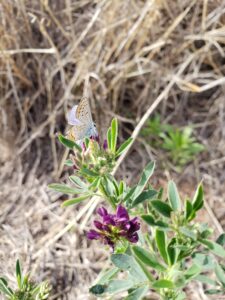
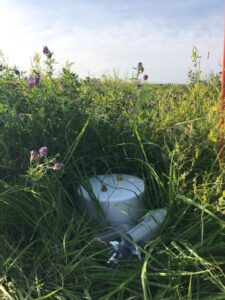
- Discover how different sources of soil nitrogen regulate the presence and activity of CH4 cycling soil microbes and GHG soil fluxes.
- Quantify how legume density influences GHG flux in established long-term pastures.
Research
Study Site and Experimental Design
We leveraged an established long-term pasture research site located at the Texas Tech University New Deal Research Farm in New Deal, TX that was previously supported and maintained by Co-PI Chuck West (now retired) and had been used in previous SARE research. For this study, we focused specifically on pasture grass base that was established in 2003, which consisted of WW-B.Dahl Old World Bluestem (OWB, Bothriochloa bladhii (Retz) S.T. Blake), in six, 2.1-ha pastures across three blocks (two pastures per block, all mapped as Pullman clay loam). Further, 20-m-2 fenced areas were established to provide long-term grazing exclusion treatments (ungrazed) within each pasture. In fall of 2016, alfalfa was interseeded into one OWB-containing pasture of each block, resulting in two pasture treatments replicated across three field blocks: 1) OWB growing alone and 2) a mixture of the OWB and alfalfa. Pastures containing only OWB received annual fertilization at a rate of 67 kg ha-1 N, with no fertilization of grass + alfalfa pastures. Alfalfa was re-seeded into one block in the fall of 2018 to correct a mediocre establishment. Alfalfa stand cover ranged from approx. 15 to 40% during summer 2019. Irrigation did not exceed 38 mm per month as needed to make up an irrigation + rainfall target of 102 mm per month. Maximum grazing-season irrigation did not exceed 152 mm to make up an irrigation + rainfall target of 408 mm. This was designed to deliver about 40% of potential ET in an average year and represent a low irrigation scenario that is realistic for SHP producers transitioning to dryland systems.
Objective 1:
For this objective, we monitored soil GHG fluxes (CH4, CO2, N2O) in long-term semi-arid pastures containing either 1) warm-season perennial grass OWB alone, or 2) OWB + alfalfa as mixed forage from the established experimental site described above. Although the effect of grazing is not a central component of this objective, we also measured GHG flux and soil microbial properties from pasture areas both inside and outside the ungrazed exclosures in each pasture for comparison.
We will collected soil GHG flux measurements using the static chamber method, following the chamber design and deployment methods and other considerations described in the USDA-ARS GRACEnet Project Protocol for soil GHG flux measurements (Parkin and Venterea, 2010). Soil GHG flux was measured biweekly during the summer growing season as weather permitted, and monthly throughout the rest of the year. Chamber bases were installed in analytical duplicates in ungrazed exclosures (two per pasture), and in four analytical replicates in grazed areas (four per pasture), resulting in 36 total chamber bases for gas measurement. Headspace gas samples were collected at 0, 15, 30, and 45-minute intervals with a 30 mL syringe. Headspace CH4, CO2, and N2O concentrations (ppm) were simultaneously measured on a GC-2014 gas chromatograph (Shimadzu Corporation, Kyoto, Japan). Soil temperature and moisture were monitored in-situ using portable field probes during gas flux measurements.
Soil cores (5 cm diameter, 5 cm depth) used to measure soil bulk density, aggregates, routine soil test nutrients, and carbon and nitrogen were collected once during the experiment. Analysis of soil physical properties are ongoing at the time of this report. Mean weight diameter (MWD) and size distribution of soil aggregates will be determined in air-dried subsamples by passing 200 g of soil through four sieve sizes, separated by dry-sieving on a Ro-Tap Test Sieve Shaker (W.S. Tyler Industrial Group, Mentor, OH). Routine soil test nutrients (including P, K, Ca, Mg, Cu, Na, S, Zn) will be measured via inductively coupled plasma (ICP) analysis in air-dried samples sent to a commercial laboratory. Soil organic carbon (SOC) and total nitrogen (TN) will be measured via high-temperature combustion analysis on a LECO TruSpec CN analyzer (LECO Corporation, St. Joseph, MI). Total soil organic matter (SOM) will also be determined via loss-on-ignition (LOI) at 400°C for 24 hrs.
Soil samples to a depth of 5 cm were collected in each pasture from the area between adjacent PVC collars at the time of soil GHG flux measurements in each of the treatment areas during the first year of study. In the second year of study, we altered the soil sampling protocol to quarterly collections to avoid oversampling the area around each collar and reduce potential confounding results from unintentionally sampling the same areas twice. We measured soil moisture and temperature at the time of soil and GHG collection, and soil pH and EC were subsequently measured in 1:1 soil: water extracts in the laboratory. To assess microbial communities, we characterized microbial biomass and community structure via ester-linked fatty acid methyl ester (EL-FAME) analysis (Schutter and Dick, 2000). From the same samples, we extracted soil inorganic nitrogen using a 1:10 ratio of soil: 2 M KCl solution and quantified the concentrations of NH4+ and NO3− in filtered extracts via spectrophotometric absorbance at 650 nm and 540 nm wavelengths, respectively (Doane & Horwáth, 2003; Weatherburn, 1967).
In soil samples collected at the end of this study, we extracted DNA from each sample for use in Illumina-based next-generation metagenomic sequencing and quantitative PCR (qPCR) assays targeting the mcrA gene for methanogenesis (Steinberg and Regan 2009; Narihiro and Sekiguchi, 2011) and the pmoA gene for methane oxidation (Kolb et al. 2003; Zeng et al., 2019) to determine the CH4-cycling potential of microbial communities in soil samples due to forage treatments. Preparations and lab work for these analyses are complete, and we are currently awaiting results from the Texas Tech University Center for Biotechnology and Genomics in Lubbock, TX.
Objective 2:
In pastures used for Objective 1 that include grass mixed with alfalfa, we identified field areas that consistently contained a gradient of alfalfa densities ranging from 0% cover to 100% cover from which to measure GHG fluxes and soil microbial properties described above. We identified three (e.g., 0-25%, 25-50%, 50-100%) legume density ranges to use for this study. This added four chamber bases for gas measurement to the total from objective 1 for each of the three OWB+alfalfa pastures, resulting in a total of 48 chamber bases (36 in objective 1 + 12 in Objective 2) for gas measurement in the overall study.
Outreach
Throughout the project period, we frequently presented the results of this study to producers and researchers at field days and events hosted by the Texas Alliance for Water Conservation (TAWC), directed by our collaborators Dr. Chuck West (retired) and Dr. Krishna Jagadish. The most recent field day was conducted on September 11, 2023. In addition, we are currently preparing a manuscript that communicates the results of each objective to submit to a peer-reviewed scientific journal in 2024.
Inclusion of a legume (alfalfa) in mix with a warm-season grass (old-world bluestem) created a stronger CH4 sink while also minimizing N2O emissions from soil compared to fertilized grass-only (old-world bluestem) pastures (Figure 1). This difference was typically greatest during the summer months following fertilization of the grass-only pasture in May (Figures 2 & 3). No consistent significant difference was detected in CH4 or N2O emissions between different alfalfa densities within grass-legume pastures (not shown), suggesting that this effect is likely due more to presence or absence of nitrogen fertilizer than to presence or absence of alfalfa. Despite a period of high soil NH4+ concentrations in grass-only plots after annual fertilization events, soil NH4+ was consistently higher in the grass-alfalfa pastures compared to the grass-only pastures, averaging 3.97 mg NH4-N kg-1 soil in grass-alfalfa pastures throughout the study period compared to 3.35 mg NH4-N kg-1 soil in grass-only pastures. We also observed higher CO2 emissions from grass-legume pastures, but only in the late spring months due to greater vegetative biomass and earlier seasonal growth of alfalfa than of the warm-season grasses (Figure 4), but the effect on cumulative CO2 emissions throughout the study period was not significant (Figure 1). Grazing had a limited effect on flux of soil GHGs such as CH4, with a small reduction in soil CH4 consumption in the early study months after grazing had ended the previous year, but no significant differences for the remainder of the study period (Figure 5). Total microbial community size measured by EL-FAME extractions was consistently higher in grass-alfalfa pastures than in grass-only pastures, but this was only statistically significant in the summer of 2021 (Figure 6).

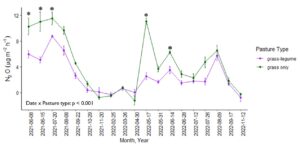
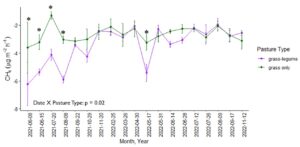
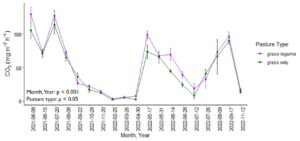
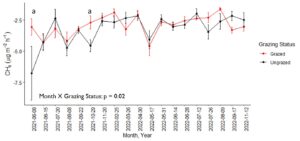
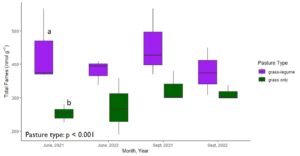
Educational & Outreach Activities
Participation Summary:
Presentations communicating this research have been delivered to producers and researchers at regional conferences and meetings (e.g., Texas Soil Survey and Land Resource Workshop in College Station, TX; Sustainable Dairy Research Meeting in Amarillo, TX in February 2022), local meetings (e.g., Annual PSS Student Research Symposium; Texas Tech University Graduate Research Symposium in May 2022), and international meetings (e.g., virtual poster presentation for the 2022 World Congress of Soil Science in Glasgow, Scotland in July/August 2022). This work was also presented at the ASA-CSSA-SSSA International Annual Meeting in Baltimore, MD, in 2022.
Project Outcomes
Our work demonstrates that producers can improve their climate footprint through reduced fertilizer application and water saving by leveraging mixed legume-grass forages can help mitigate soil greenhouse gas emissions in semi-arid pasture soils. Legumes provide an important source of digestible protein for grazing livestock as well as a source of soil N for improved nutrient cycling dynamics and soil health; our work further shows that compared to fertilized grass-only pastures, adding legumes can help soils consume more atmospheric CH4, reduce N2O emissions, and increase soil microbial biomass in semi-arid pastures. With rising fertilizer prices and costs of production, increased vulnerability to drought and soil erosion, and the continuing need to reduce the climate footprint of agroecosystems, our study provides compelling supportive evidence for producers that incorporating legumes into pastures can help them reach their sustainability goals.
Throughout this project, we have gained a better understanding of the differences and practicality of managing nitrogen in semi-arid pastures through either nitrogen fertilizer or legume addition. Previous work from collaborators in the same pastures has shown that adding legumes instead of fertilizing grass-only pastures can provide a good source of protein for grazing cattle and improve animal weight gain. Our work showed that mixed alfalfa and warm-season old world bluestem forage can also help mitigate soil greenhouse gas emissions (CH4 and N2O) from semi-arid pastures compared to managing grass-only stands with fertilizer. This has led to proposals funded to extend this work and enable year-round soil GHG collections at this site, as well as new collaborations and proposals submitted with crop physiologists and rangeland scientists to explore the use of native or introduced legumes to build soil health and mitigate climate change impacts in semi-arid agroecosystems. Working in the fields and communicating with pasture managers and producers has also reinforced our appreciation for the additional benefits of legume inclusion to sustainability and agricultural production such as through greater presence of pollinators and wildlife (e.g., the threatened Texas horned lizard) in the mixed forage pastures than in grass-only pastures or adjacent row crop systems.